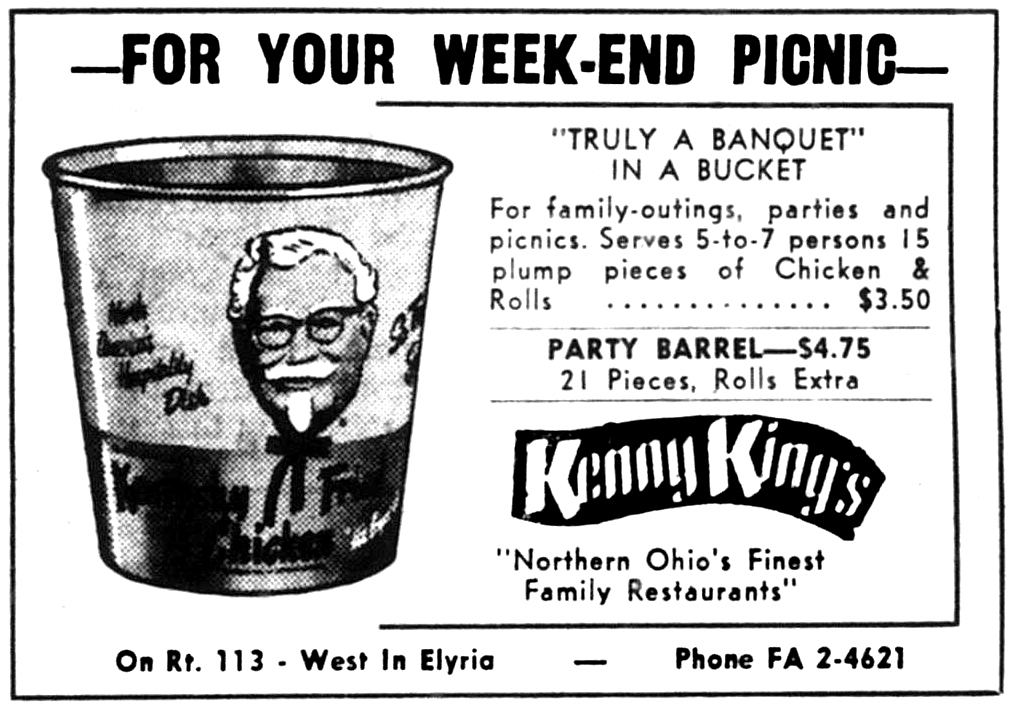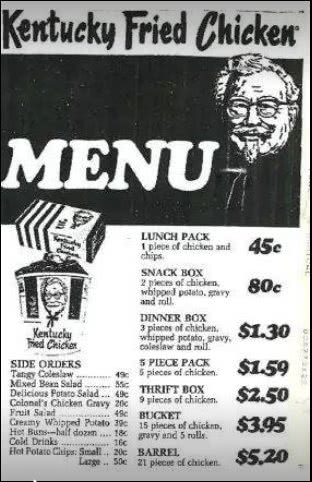KFC Through the Years: Vintage Menus and Ads that Will Take You Back
 •
by
•
by ChievoKevin

KFC, the fast-food giant, has been a household name for decades, known for its mouth-watering fried chicken and delicious sides.
However, have you ever wondered what KFC looked like in its early days? What were the prices like? How was the food advertised?
In this article, we take a trip down memory lane and showcase vintage photos of KFC’s menus and early advertisements that will make you feel nostalgic.
These vintage pictures not only depict the evolution of the brand, but also highlight how much things have changed since the early days of KFC.
From the affordable prices to the unique marketing tactics, these old photos of menus and ads will take you on a journey through time, allowing you to experience KFC’s historical journey.

KFC was founded by Colonel Harland Sanders (1890–1980), an entrepreneur who began selling fried chicken from his roadside restaurant in Corbin, Kentucky, during the Great Depression.
Sanders identified the potential of the restaurant franchising concept and the first “Kentucky Fried Chicken” franchise opened in Salt Lake City, Utah in 1952.
KFC popularized chicken in the fast-food industry, diversifying the market by challenging the established dominance of the hamburger.
By branding himself as “Colonel Sanders”, Harland became a prominent figure of American cultural history and his image remains widely used in KFC advertising to this day.
However, the company’s rapid expansion overwhelmed the aging Sanders and he sold it to a group of investors led by John Y. Brown Jr. and Jack C. Massey in 1964.

KFC’s original product is pressure-fried chicken pieces, seasoned with Sanders’ signature recipe of “11 herbs and spices”. The constituents of the recipe are a trade secret.
Larger portions of fried chicken are served in a cardboard “bucket”, which has become a feature of the chain since it was first introduced by franchisee Pete Harman in 1957.
KFC has been an extensive advertiser since the establishment of the first franchise in 1952. Founder Harland Sanders initially developed his “Colonel” persona as a low-cost marketing tool.
The Colonel’s image is still used extensively in the chain’s advertising. The chain is well known for the “finger lickin’ good” slogan, which originated in 1956.

Colonel Sanders was a key component of KFC advertising until his death in 1980. He made several appearances in various B movies and television programs of the period, such as What’s My Line? and I’ve Got a Secret. Jack Massey described him as “the greatest PR man I have ever known”.
KFC franchisee and Wendy’s founder Dave Thomas credited Sanders’ appeal to the fact that he “stood for values that people understood and liked”.
Since his death Sanders has remained as a key symbol of the company; an “international symbol of hospitality”.

Sanders’ Original Recipe of “11 herbs and spices” is one of the most famous trade secrets in the catering industry.
Franchisee Dave Thomas, better known as the founder of Wendy’s, argued that the secret recipe concept was successful because “everybody wants in on a secret” and former KFC owner John Y. Brown, Jr. called it “a brilliant marketing ploy.”
The New York Times described the recipe as one of the company’s most valuable assets. The recipe is not patented, because patents are published in detail and come with an expiration date, whereas trade secrets can remain the intellectual property of their holders in perpetuity.

KFC uses its Original Recipe as a means to differentiate its product from its competitors. Early franchisee Pete Harman credited the chain’s popularity to the recipe and the product, and John Y. Brown cites the “incredibly tasty, almost addictive” product as the basis of KFC’s staying power.
On the other hand, Allen Adamson, managing director of brand consultancy Landor, remains unconvinced about the contribution of the secret formula aspect.
He argues: “The story may still be part of these companies’ folklore, but I’d be surprised if more than 2 percent buy the brand because of it.”

A copy of the recipe, signed by Sanders, is stored within a vault at KFC’s Louisville headquarters, along with 11 separate vials that each contain one of the ingredients.
KFC employs two different firms, Griffith Laboratories and McCormick & Company, to formulate the blend; in order to maintain secrecy, each firm is given a different half of the recipe.
Once the Griffith portion has been formulated, it is sent to McCormick and combined with the remaining ingredients there.
The first KFC logo was introduced in 1952 and featured a “Kentucky Fried Chicken” typeface and a logo of the Colonel. It was designed by the Lippincott & Margulies corporate identity agency.
Lippincott & Margulies were hired to redesign it in 1978, and used a similar typeface and a slightly different Sanders logo.
The “KFC” acronym logo was designed by Schechter & Luth of New York and was introduced in 1991, and the Colonel’s face logo was switched from brown to blue ink.
Landor redesigned the logo in 1997, with a new image of the Colonel. The new Colonel image was more thinly lined, less cartoonish and a more realistic representation of Sanders.
In 2007, the Colonel logo was updated by Tesser of San Francisco, replacing his white suit with an apron, bolder colors and a better defined visage.
According to Gregg Dedrick, president of KFC’s US division, the change, “communicates to customers the realness of Colonel Sanders and the fact that he was a chef”.



Comments
The famous colonel
Successfully transferred 500 item(s) to M.H.P.C.
https://www.erepublik.com/en/article/end-horse-2767880/1/20
https://www.erepublik.com/en/article/endorse-nya-dong-om-sama-tante--2767493/1/20
https://www.erepublik.com/en/article/endorse-nya-dong-om-sama-tante--2767493/1/20
v!
Successfully transferred 500 item(s) to Armenicious.
O7
Successfully transferred 500 item(s) to Limitless33.
#SPRINGBREAK 2023 / ENDORSE & Missions - Day 5,619
erepublik.com/en/article/2765827
https://www.erepublik.com/gr/article/endorse-51-2767772
https://www.erepublik.com/en/article/endorsements1-2766804/1/20
Eat mor chikin